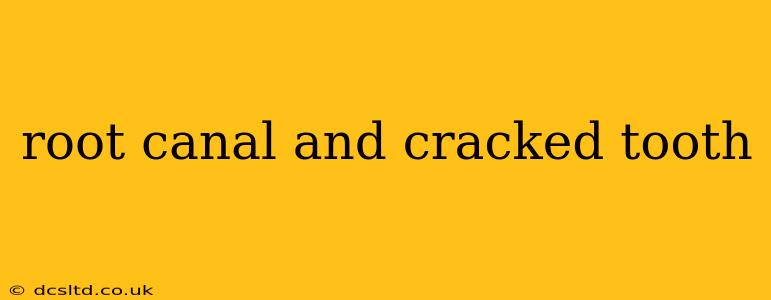A cracked tooth and the need for a root canal are often intertwined, creating a dental emergency that requires prompt attention. Understanding the relationship between these two conditions is crucial for effective treatment and preventing further complications. This comprehensive guide will explore the connection between cracked teeth and root canals, outlining the symptoms, diagnosis, and treatment options available.
What is a Cracked Tooth?
A cracked tooth, also known as a fractured tooth, refers to any type of break in the tooth enamel. These cracks can range from tiny, hairline fractures invisible to the naked eye to large, visible breaks that extend through the entire tooth structure. The location and severity of the crack significantly impact the necessary treatment. Cracks can develop in various parts of the tooth, including:
- Craze lines: These are tiny, superficial cracks that don't penetrate the enamel and generally don't require treatment.
- Fractured cusp: This involves a break in the pointed cusp (the chewing surface) of the tooth.
- Vertical root fracture: This is a serious crack that extends from the crown of the tooth down into the root, often requiring extraction.
- Cracked tooth syndrome: This is a challenging condition where the crack isn't always easily visible on X-rays, making diagnosis difficult. Symptoms can include sharp pain while chewing, temperature sensitivity, and pain that comes and goes.
How Does a Cracked Tooth Lead to a Root Canal?
A root canal becomes necessary when the crack in your tooth reaches the pulp, the soft tissue inside the tooth containing nerves and blood vessels. When bacteria enter the pulp through the crack, it causes inflammation and infection, leading to severe pain, swelling, and potential abscess formation. A root canal is a procedure designed to remove the infected pulp, clean the canals, and seal the tooth to prevent further infection.
What are the Symptoms of a Cracked Tooth?
Recognizing the symptoms of a cracked tooth is crucial for timely intervention. These symptoms can vary depending on the severity and location of the crack:
- Sharp, shooting pain: Pain is often triggered by chewing, biting, or temperature changes (hot or cold).
- Sensitivity to pressure: The affected tooth may be sensitive to pressure when biting down.
- Lingering pain: The pain might persist even after the stimulus is removed.
- Swelling: If the infection reaches the gum tissue, swelling can occur.
- Discoloration: The tooth might darken or change color over time.
What if I think I have a cracked tooth? Should I see a dentist immediately?
Yes, it's crucial to see a dentist immediately if you suspect you have a cracked tooth. Early diagnosis and treatment are essential to prevent further complications and preserve the tooth. Delaying treatment can lead to a more extensive infection requiring more complex procedures or even tooth extraction.
Can a cracked tooth heal on its own?
No, a cracked tooth will not heal on its own. The crack provides an entry point for bacteria, leading to infection and potentially the need for a root canal or extraction. Seeking professional dental care is the only way to address a cracked tooth effectively.
How is a cracked tooth diagnosed?
Diagnosing a cracked tooth can sometimes be challenging, particularly in cases of cracked tooth syndrome. Your dentist will conduct a thorough examination, including a visual inspection, bite test, and often X-rays. They might also use a dye to help visualize the crack.
What are the treatment options for a cracked tooth requiring a root canal?
Treatment options depend on the severity and location of the crack:
- Root Canal Treatment: If the crack reaches the pulp, a root canal is necessary to remove the infected tissue, clean the canals, and seal the tooth to prevent further infection. Often, a crown is placed over the tooth afterward for added protection and strength.
- Crown: A crown (cap) is typically placed over the tooth after a root canal to protect and restore its functionality and appearance.
- Extraction: In cases of severe vertical root fractures, extraction might be necessary. The extracted tooth may be replaced with a bridge, implant, or partial denture.
How can I prevent cracked teeth?
Preventing cracked teeth involves practicing good oral hygiene and avoiding habits that put excessive stress on your teeth:
- Avoid biting hard objects: Refrain from chewing ice, hard candies, or using your teeth as tools.
- Wear a mouthguard: If you play contact sports, wear a custom-fitted mouthguard to protect your teeth from injury.
- Practice good oral hygiene: Regular brushing, flossing, and dental checkups can help maintain strong teeth and prevent problems.
- Manage bruxism (teeth grinding): If you grind your teeth, discuss treatment options with your dentist, such as a night guard.
By understanding the connection between cracked teeth and root canals, individuals can take proactive steps to prevent these issues and seek appropriate treatment when necessary. Early intervention is key to preserving the natural tooth and minimizing the need for extensive dental procedures. Remember, your dentist is your best resource for diagnosis and treatment planning.
